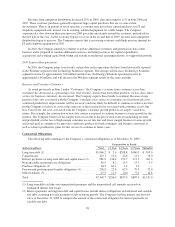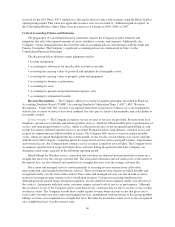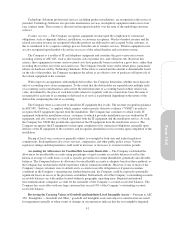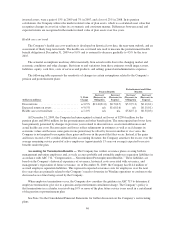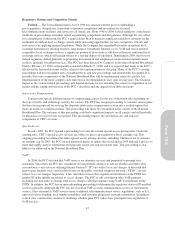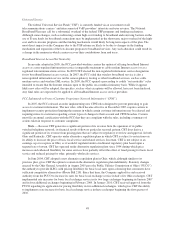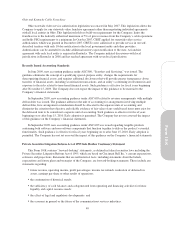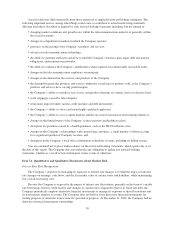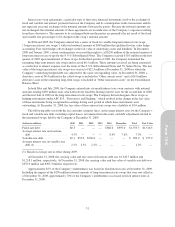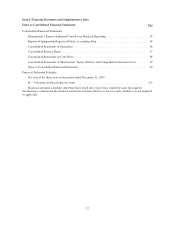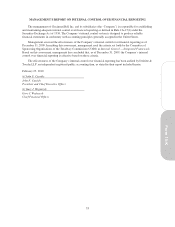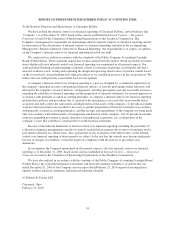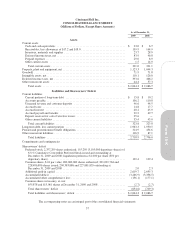Cincinnati Bell 2009 Annual Report Download - page 117
Download and view the complete annual report
Please find page 117 of the 2009 Cincinnati Bell annual report below. You can navigate through the pages in the report by either clicking on the pages listed below, or by using the keyword search tool below to find specific information within the annual report.
Regulatory Matters and Competitive Trends
Federal — The Telecommunications Act of 1996 was enacted with the goal of establishing a
pro-competitive, deregulatory framework to promote competition and investment in advanced
telecommunications facilities and services to all Americans. From 1996 to 2008, federal regulators considered a
multitude of proceedings ostensibly aimed at promoting competition and deregulation. Although the Act called
for a deregulatory framework, the FCC’s approach has been to maintain significant regulatory restraints on the
traditional incumbent local exchange carriers while increasing opportunities for new competitive entrants and
new services by applying minimal regulation. While the Company has expanded beyond its incumbent local
exchange operations by offering wireless, long distance, broadband, Internet access, VoIP and out-of-territory
competitive local exchange services, a significant portion of its revenue is still derived from its traditional local
exchange services, which still remain subject to a varying degree of regulation. Beginning in 2009, the focus of
federal regulators shifted primarily to promoting investment in and adoption of advanced telecommunications
services, primarily broadband services. The FCC has been directed by Congress to develop a National Broadband
Plan by February 17, 2010 (subsequently extended to March 17, 2010) and it is expected that much of the FCC’s
efforts for the foreseeable future will be related to the implementation of that plan. Many of the FCC’s existing
proceedings will be reexamined with a broadband focus and new proceedings will undoubtedly be opened. It is
possible that some components of the National Broadband Plan will be implemented relatively quickly, but
implementation of the more complex and controversial recommendations may span several years. The financial
impact of the various federal proceedings will depend on many factors including the extent of competition in our
market and the timing and outcome of the FCC’s decisions and any appeals from those decisions.
Intercarrier Compensation
Current rules specify different means of compensating carriers for the use of their networks depending on
the type of traffic and technology used by the carriers. The FCC has an open proceeding to consider various plans
that have been proposed for revising the disparate intercarrier compensation system into a unified regime that
treats all traffic in a uniform manner. This proceeding will likely be reexamined in the context of the National
Broadband Plan. The outcome of this proceeding could have significant impacts on all carriers and will probably
be phased-in over a five to ten year period. This proceeding impacts the switched access and end-user
components of CBT’s revenue.
Special Access
In early 2005, the FCC opened a proceeding to review the current special access pricing rules. Under the
existing rules, CBT’s special access services are subject to price cap regulation with no earnings cap. This
ongoing proceeding reexamines the entire special access pricing structure, including whether or not to reinstate
an earnings cap. In 2007, the FCC invited interested parties to update the record and in 2009 initiated a process to
more thoroughly analyze whether the existing rules ensure just and reasonable rates. This proceeding is also
likely to be addressed in the National Broadband Plan.
VoIP
In 2004, the FCC declared that VoIP services are interstate services and purported to preempt state
regulation. Since then, the FCC has considered several petitions asking it to rule on whether and under what
circumstances voice services utilizing Internet Protocol (“IP”) are subject to access charges. It has ruled that
peer-to-peer Internet voice services that do not use the public switched telephone network (“PSTN”) are not
subject to access charges. Separately, it has ruled that services that originate and terminate on the PSTN but
employ IP in the middle are subject to access charges. The FCC is still considering other VoIP petitions,
including one that seeks to exempt from access charges calls that originate using VoIP, but terminate on the
PSTN. In addition, the FCC has an open rulemaking proceeding to determine the regulatory status of IP-enabled
services generally. Although the FCC has not classified VoIP as a telecommunications service or information
service, it has extended to VoIP services many traditional telecommunications service regulations, such as 911,
universal service funding, local number portability, and customer proprietary network information. In addition,
several state commissions continue to challenge whether prior FCC orders have preempted state regulation of
VoIP services.
47
Form 10-K



